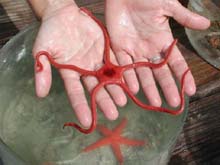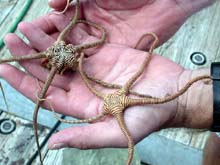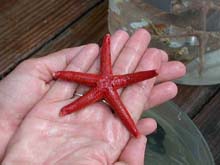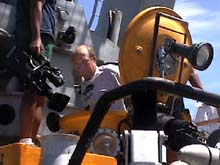Interview with John Reed
Senior Research Specialist
Harbor Branch Oceanographic Institution
September 4, 2001
![]() View a video of an Oculina coral reef. (4.2 MB, QuickTime
View a video of an Oculina coral reef. (4.2 MB, QuickTime ![]() required).
required).
Ocean Explorer: Are Oculina coral communities your primary research interest?
John Reed: This is my passion. It was my primary research project for 10 yrs, and has continued for more than 25 yrs. I started in 1976, about a year after scientists at Harbor Branch Oceanographic Institution discovered Oculina Bank. I began by learning everything I could about the reefs. It turned out that while the deep-water form of Oculina ranges from Florida to North Carolina, the high-relief, bush-like Oculina structures occur only along the edge of the continental shelf of eastern Florida -- from Fort Pierce to Daytona Beach -- and apparently nowhere else in the world.
After mapping its distribution with the Johnson Sea Link submersibles in the late 1970s, I wanted to look at the coral itself -- its morphology, growth rates, and the animal communities associated with the coral. I discovered that Oculina grows only about one-half inch per year, which means that the large, 5-ft-wide, 5-ft-tall colonies are more than 100 yrs old. This is similar to the growth rates of other deep-water coral species. (![]() See a short video of a deep water Oculina reef.) Next, I wanted to find out, "What is the food web? Which animals live inside the coral structure?" I made periodic submersible dives in the 1990s on the Oculina reefs, but since 1986, I have worked in Harbor Branch's marine biomedical research division, focusing on the discovery of novel chemicals from marine organisms that may cure human diseases, such as cancer. Thus, these dives now serve two purposes for my research.
See a short video of a deep water Oculina reef.) Next, I wanted to find out, "What is the food web? Which animals live inside the coral structure?" I made periodic submersible dives in the 1990s on the Oculina reefs, but since 1986, I have worked in Harbor Branch's marine biomedical research division, focusing on the discovery of novel chemicals from marine organisms that may cure human diseases, such as cancer. Thus, these dives now serve two purposes for my research.

The giant red brittle star, Ophioderma, is found only in Oculina habitat. This one was found on Sebastian's Reef. Click image for larger view.
Ocean Explorer: What kind of diversity do you find in the Oculina reef community, and why?
John Reed: The deep-water Oculina reef is as species-rich as any shallow-reef community. There are hundreds of species of worms, sponges, brittle stars, crabs, shrimp, and mollusks. In one volleyball-sized coral head, I found more than 2,000 animals, including filter feeders, detritivores (detritus feeders), corallivores (coral eaters), carnivores, and scavengers. With the diverse spatial structure that the coral provides, there is habitat space for many different species to live together harmoniously in the Oculina reefs. These creatures attract small fish, which, in turn, feed predators such as gag and scamp grouper, snapper, and amberjack, all of which were abundant in the 1970s.
Additionally, the Gulf Stream, together with upwelling events that occur on the shelf edge, serve to feed the entire ecosystem. Cold water welling up from the depths of the Straits of Florida produces a tenfold increase in nutrient levels, which results in plankton blooms and food for the reef community. This water periodically washes up and over the Oculina Banks at the edge of the continental shelf. It's like spreading natural fertilizer on a lawn.
Ocean Explorer: How many dives have you made in this area?
John Reed: Since 1976, I've made more than 100 sub dives, to depths reaching 3,000 ft, off the east coast of Florida. I did the majority of my studies in an area known as Jeff's Reef, a spectacular, 60-ft-high Oculina reef at a depth of 270 ft in the Sebastian Pinnacles region.
Ocean Explorer: Regarding the dives that have taken place during the last several days of this expedition, what is your impression of the current state of Oculina Bank, as compared to 25 years ago?
John Reed: It's sad. With the exception of Jeff's Reef, many of the reef sites have extensive dead coral. The one reef that really proved the difference was the Cape Canaveral pinnacle. We had documented that the pinnacle measured about 60 ft high. In submersible dives from 1976 to 1978, we documented that the west slope was coral rubble, the top was about 25% live coral, and in some areas, 100% live, massive coral bushes grew 5 ft high. During this week's expedition, we made video transects with the submersible, and the only place with any live coral was a small patch near the base of the reef. The rest of it has died, and that is heartbreaking. When I submitted this area for consideration as a National Marine Sanctuary and a marine protected area in 1981, I know we had a lot more live coral. Over the last week, I've been on four dives in a 300-sq-mi area. We barely scratched the surface, but what I have seen was devastating, and it really kind of crushed me.
Still, in areas where standing dead coral remains (it hasn't been crushed and turned to rubble), the coral is supporting tremendous diversity. Scattered and small as these stands are, they are still providing habitat. We did see gag and scamp, but of smaller size than 20 yrs ago, and in greatly reduced numbers. When you come up to a coral ridge, it's like a mini-aquarium, but then I remember what it used to be like. Once, when I was lockout diving from the submersible on Jeff's Reef, I had to repeatedly push off a 300-lb, 5-ft-long warsaw grouper who kept nosing in on me while I was measuring the coral growth. He actually grabbed the ruler out of my hand!

Brown-striped brittle stars (Astroporpa annulata) collected on Sebastian's Reef. Click image for larger view.

A red starfish from Sebastian's Reef. Click image for larger view.
Ocean Explorer: Can you say what accounts for the difference between what you see now and what you saw in the 1970s?
John Reed: I have no explanation as to why there is more standing dead coral than before. Where we see coral rubble spread across the bottom, trawling certainly has had an impact, but it's impossible to pinpoint when the trawling occurred. There was extensive dead coral in the 1970s, too. The U.S. Navy peppered this area with depth charges in the 1940s in pursuit of German U-boats. We have not found evidence of that activity, but that may have contributed. Perhaps some of the dead coral is due to natural bioerosion, periodic die-offs, pathogens, or currents. We do know that trawling has occurred since the protected area was established. Three trawlers were spotted just last year, apparently dragging their nets within the Oculina reserve; one was caught, and fined $15,000 for fishing for rock shrimp in a closed area. The vessel had nearly 3,000 lbs of rock shrimp and 5,600 lbs of brown shrimp on board, and a NOAA Fisheries Enforcement agent also found Oculina coral on board.
Ocean Explorer: What would you like to see happen? Do you think the protected area should be smaller, so as to concentrate protection efforts on the remaining healthy Oculina communities?
John Reed: It's difficult to say how effective the ban on bottom fishing has been within the Oculina reserve. Unfortunately, very little surveillance and enforcement occur, due to the lack of funds and the distance from shore. We simply do not know how much illegal fishing has continued since the ban was placed in effect in 1994. If we give up and let it go, though, the Oculina will never grow back. I would like to see more surveillance. There isn't enough enforcement, and fines and penalties need to provide more incentive for compliance. My focus is on educating the public, recreational and commercial fishermen, and government agencies. People need to understand the importance of the habitat. Let the coral and the grouper have a chance to come back. It's very hard to prove that this will work, but it just makes common sense that if the fish are protected in this small area, they will stray from the protected area, and will eventually spill out into adjacent reefs on the shelf.
Sign up for the Ocean Explorer E-mail Update List.












































